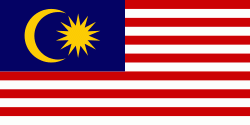Nibong Tebal (Nibong Tebal)
 |
Founded as an agricultural village, Nibong Tebal now houses light industries as well, including one of Malaysia's largest manufacturers of paper products. It also the headquarters of the Malaysian pulp and paper company, Nibong Tebal Paper Mill.
Nibong Tebal had been in existence since the early 19th century as an agricultural village. Sugar harvesting formed the mainstay of Nibong Tebal's economy during its early years; the industry was dominated by the Europeans due to their technological superiority. By the mid-19th century, Penang Sugar Estates Limited, which was based in Nibong Tebal, became the largest producer of sugar within Province Wellesley (now Seberang Perai). Upon the death of its owner, Edward Horsman, the Ramsden family, one of Britain's richest families, acquired the company. European influence in Nibong Tebal soon permeated into the area's social fabric, with the arrival of Catholic missionaries in the late 19th century.
By then, Nibong Tebal had attracted significant numbers of Chinese immigrants. A Taoist temple had been built in the area in 1866. Nibong Tebal also became a stronghold of the Ghee Hin Kongsi, one of the active Chinese secret societies in Penang at the time.
In 1900, the nascent railway line between Perai and Bukit Mertajam was extended to Nibong Tebal, and by 1902, the railroad was joined to Perak's new railway line as well. This boosted Nibong Tebal's new role as a transportation hub, a role which was maintained until the 1930s. The completion of a road bridge across the Kerian River led to Nibong Tebal's decline as a transportation hub.
Map - Nibong Tebal (Nibong Tebal)
Map
Country - Malaysia
 |
 |
| Flag of Malaysia | |
Malaysia has its origins in the Malay kingdoms, which, from the 18th century on, became subject to the British Empire, along with the British Straits Settlements protectorate. Peninsular Malaysia was unified as the Malayan Union in 1946. Malaya was restructured as the Federation of Malaya in 1948 and achieved independence on 31 August 1957. The independent Malaya united with the then British crown colonies of North Borneo, Sarawak, and Singapore on 16 September 1963 to become Malaysia. In August 1965, Singapore was expelled from the federation and became a separate independent country.
Currency / Language
| ISO | Currency | Symbol | Significant figures |
|---|---|---|---|
| MYR | Malaysian ringgit | RM | 2 |
| ISO | Language |
|---|---|
| ZH | Chinese language |
| EN | English language |
| MS | Malay language |
| ML | Malayalam language |
| PA | Panjabi language |
| TA | Tamil language |
| TE | Telugu language |
| TH | Thai language |















